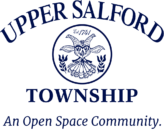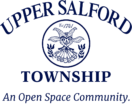Stormwater Ordinance
Upper Salford Township adopted a Stormwater Management Ordinance (Ordinance 2005-2) on February 8, 2005. A new subchapter of the Stormwater Management Ordinance (Ordinance 2006-1), addressing stormwater management for properties in the East Branch Perkiomen Creek Watershed, was adopted on April 19, 2006.
Stormwater Management in Conjunction with Building
Stormwater
Stormwater is the precipitation that falls on roofs, lawns and paved areas and is carried away by a system of stormwater pipes, culverts and ditches. Collectively, the draining water is called storm water runoff.
The Problem
Stormwater becomes a problem when it picks up debris, chemicals, dirt, pet waste and other pollutants as it flows into the waterbodies we use for swimming, fishing and drinking untreated. Excessive debris can clog inlets causing flooding and erosion of stream banks.
Municipal Separate Storm Sewer System (MS4)
Small MS4 Program Overview
Stormwater Phase II Final Rule Fact Sheet Series (EPA)
Stormwater Discharges from MS4s
Stormwater pollution is caused by so many different activities that traditional regulatory controls cannot handle the problem. Polluted storm water runoff is often transported to municipal separate storm sewer systems (MS4s) and ultimately discharged into local rivers and streams without treatment. EPA’s Storm Water Phase II Rule establishes an MS4 storm water management program that is intended to improve the nation’s waterways by reducing the quantity of pollutants that storm water picks up and carries into storm sewer systems during storm events. Common pollutants include oil and grease from roadways, pesticides from lawns, sediment from construction sites and carelessly discarded trash such as cigarette butts, paper wrappers and plastic bottles.
The Six MS4 program elements, termed “minimum control measures,” are outlined below:
1. Public Education and Outreach
Distributing educational materials and performing outreach to inform citizens about the impacts polluted storm water runoff discharges can have on water quality.
2. Public Participation and Involvement
Providing opportunities for citizens to participate in program development and implementation, including effectively publicizing public hearings and/or encouraging citizen representatives on a storm water management panel.
3. Illicit Discharge Detection and Elimination
Developing and implementing a plan to detect and eliminate illicit discharges to the storm sewer system (including developing a system map and informing the community about hazards associated with illegal discharges and improper disposal of waste).
4. Construction Site Runoff Control
Developing, implementing and enforcing an erosion and sediment control program for construction activities that disturb one or more acres of land (controls could include silt fences and temporary storm water detention ponds).
5. Post-Construction Runoff Control
Developing, implementing and enforcing a program to address discharges of post-construction storm water runoff from new development and redevelopment areas. Applicable controls could include preventative actions such as protecting sensitive areas (e.g., wetlands) or the use of structural BMPs such as grassed swales or porous pavement.
6. Pollution Prevention/Good Housekeeping
Developing and implementing a program with the goal of preventing or reducing pollutant runoff from municipal operations. The program must include municipal staff training on pollution prevention measures and techniques (e.g., regular street sweeping, reduction in the use of pesticides or street salt, or frequent catch-basin cleaning) or its chosen BMPs and measurable goals for each minimum control measure. To help permittees identify the most appropriate BMPs for their programs, EPA will issue a “menu” of BMPs to serve as guidance. NPDES permitting authorities can modify the EPA menu or develop their own list.
Important Ways to Prevent Storm Water Pollution
- Properly dispose of hazardous substances such as used oil, cleaning supplies and paint – never pour them down any part of the storm sewer system and report anyone who does.
- Use pesticides, fertilizers and herbicides properly and efficiently to prevent excess runoff.
- Look for signs of soil and other pollutants, such as debris and chemicals, leaving construction sites in storm water runoff or tracked into roads by construction vehicles. Report poorly managed construction sites that could impact storm water runoff to your community.
- Install innovative storm water practices on residential property, such as rain barrels or rain gardens, that capture storm water and keep it on site instead of letting it drain away into the storm sewer system.
- Report any discharges from storm water outfalls during times of dry weather – a sign that there could be a problem with the storm sewer system.
- Store materials that could pollute storm water indoors and use containers for outdoor storage that do not rust or leak to eliminate exposure of materials to storm water.
Educational Materials from The
Perkiomen Watershed Conservancy
What is an Illicit Discharge?
Federal regulations define an illicit discharge as any discharge to the storm sewer system that is not composed entirely of stormwater. There are exceptions to this rule such as firefighting activities, landscape irrigation, foundation drains, water from crawl space pumps, etc.
Sources of Illicit Discharges Include
- Sanitary Wastewater
- Failing Septic Systems
- Car Wash Waste Water
- Improper Oil Disposal
- Radiator Flushing Disposal
- Spills From Roadway Accidents
- Improper Disposal of Household Toxic or Improper Use of Pesticides and Herbicides, etc.
Where to Go to Continue the Information Flow
Your community is preventing storm water pollution through a storm water management program. This program addresses storm water pollution from construction, new development, illegal dumping to the storm sewer system, and pollution prevention and good housekeeping practices in municipal operations. It will also continue to educate the community and get everyone involved in making sure the only thing that storm water contributes to our water is… water! Contact your community’s storm water management program coordinator of the Pennsylvania Department of Environmental Protection (DEP) for more information about storm water management.
Public Participation and Education
Increase your Environmental and Stormwater Awareness and Get Involved!
Information Presentations
Other Sites to Visit
Homeowner Information
- Flood Related Information – Website provides information before, during and after the storm.
Agriculture
Montgomery County Conservation District Agricultural Program:
Contact Guy Meyer: (610) 489-4506, x14
Nutrient Management Program

